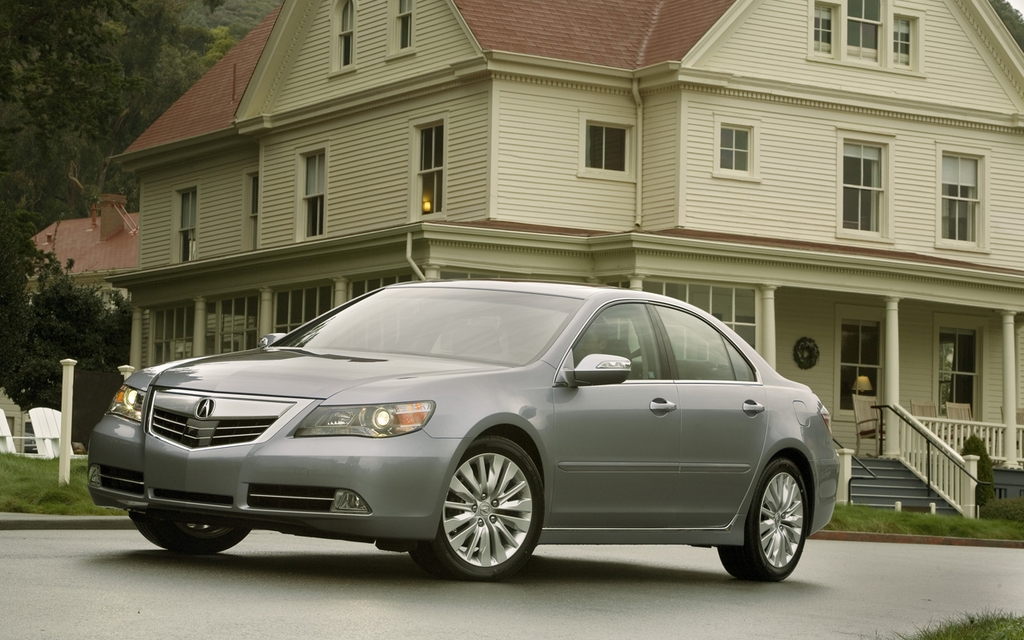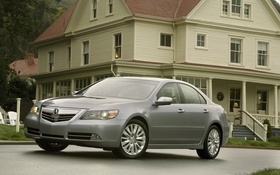2011 Acura RL: Evidence of an identity crisis

| Strong points |
|
|---|---|
| Weak points |
|
This car is representative of everything that can go wrong with the auto industry. Don't mistake the sentiment; it's hardly a bad car. One only need look at the biggest of Acura's track record to discern that Honda's most luxurious car is anything but. Well liked, as reliable as an anvil, and not displeasing to gaze upon, it's the absolute evolution of the same thinking that's rewarded the market with some of the most reliable and successful vehicles on the market today; namely the Honda Civic and Toyota Corolla. And it's going to kill Acura unless they can stop it.
Which is somewhat odd when you consider that the RL is, in some ways, the most traditional of Acura automobiles. Whilst the remainder of the Acura lineup prefers to squat low behind oft-criticized front grilles of epic proportions, their headlights twinkling through uniquely anime-inspired headlights, the RL looks downright resplendent alongsides. Stately and well proportioned, it's restrained lines and shapes bring as much class and sophistication to the showroom floor as the ZDX's do raised eyebrows.
And it's class and sophistication certainly isn't skin deep. Inside, outside, and underneath, the RL proves itself superbly constructed. From the ridiculously expensively manufactured wiper arms to the uniform and tight panel gaps to the perfect fit of the interior panels, nearly everything is made of first rate materials and put together with a level of care that you just don't see very often. From its soft-touch rubbery seat heater switches (they're definitely the nicest seat heater, nay, switches on the market, complete with blue and red LED status indicators) to its graceful and beautifully trimmed interior door pulls, it's reminiscent of the same quality that earned Japanese products world renown a couple decades ago.
So, if it's a handsomely made car, assembled well, and constructed of some fantastic parts, how is it tolling the death knell for a company that's only now celebrating their 25th anniversary in Canada? Because although it may be Acura's flagship, and should espouse all of the brand's most important values, it feels more akin to a money-no-object version of the Honda Civic: compromisingly inoffensive in absolutely every way. The 3.7L V6 and SH-AWD system channel the downright sensible 300 horsepower to the road in a manner that's traded every ounce of personality for practicality, and the traditional, non-adjustable suspension handles sitting atop the fence between comfort and performance better than it does lateral g-forces or large bumps. Milquetoast in almost all of its mannerisms, it's a car that's equally unlikely to draw complaint or compliment as it goes about it's perfectly respectable business in perfectly respectable ways.
I believe the RL to be a victim of Acura's corporate culture, or lack thereof. Consider, if you will, the companies behind its chief competitors: BMW, Mercedes, Audi and Lexus. Undoubtedly, in your mind's eye, you can form an image of the people responsible for each. At the Teutonic design studious of Audi, BMW and Mercedes, I imagine flocks of exuberantly engineering Germans working in sanitized design rooms resplendent in white light and trimmed with billet aluminum, whilst quiet Japanese designers take cues from the rock garden outside their window and look for ways to improve upon every single detail of a design at Lexus' California-based design studios. But whenever I think of Acura's offices, I can't seem to drive the image of Peter Gibbons, Michael Bolton, and Samir Nagheenanajar toiling away in cubicles beneath the watchful eyes of Bill Lumbergh and a million flourescent tubes. And it's a shame, too, because if you'd asked me the same question in my youth, I'd have pointed to unforgettable cars like the Acura NSX and Integra Type R as evidence of Acura's existence as the "exciting" Japanese manufacturer, and imagined to lab-coated engineers crawling over car and driver alike in pit lanes all over the world, gleaning every bit of information they can from both to improve their performance.
When Acura realized they were suffering an identity crisis, they shouldn't have stuck giant shields on the prows of their entire lineup, they should have pursued a new halo sports car, or flagship sedan. Cars like those give a brand something to rally around; a nucleus upon which the rest of the brand can build. Be it the Ford GT, the Audi R8, a Mercedes SLS, a Lexus LF-A or the upcoming BMW i8, the uncompromising personality of a flagship car trickles down into every car that follows, be it a cheap hatchback runabout or a full blooded sports car, and more importantly, imbues the corporation that created it with a bit of its identity as well. Without such a vehicle, the lineup languishes, and further development is driven not by the excitement of its core group of enthusiastic engineers and designers, but rather by the score-keeping accountants and segment-obsessed marketers. And when that happens, you get friendly, politically correct, harmless and unobjectionable cars like the RL. But this is Acura we're talking about here; a young, vivacious company that once saw the merits in having none other than Ayton Senna critique and improve their NSX's handling, and brought perhaps one of the last true homologation specials to the market with the Integra Type R. So please Acura, for your sake and ours, I implore you: rage against the dying of the light and do not go gently into that good night.











